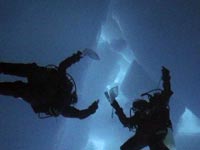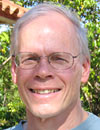|
  Today's Weather Sunny Latitude: 64 56.07 S Longitude: 66 51.62 W Wind: 32 KT Sea State: 5 Swell Height: 4 Baro Pressure: 980.1 mB Air Temp: 3.8°C Sea Surface Temp: 3.5 °C Vis: Clear 
  Check out the new Hot Topic with videos! Antarctic Water Wear: Cold-Water Diving and Drysuits February 28, 2006 by Kate Madin We’re steaming to a new location, a point on the chart 110 (177 kilometers) miles away. At the Gould’s cruising speed, it takes 11 hours. Scientists get to sleep, read, or do laundry. The crew, though, is still at work—certainly in the galley (the ship’s kitchen), where the steward and two cooks produce meals in a smooth routine, even when seas get rough. The Gould’s galley is bright, and outfitted with stainless steel counters and appliances, and a walk-in storage room. It looks like a kitchen in a small restaurant. Steward Romeo Agonias was taking delicious-looking golden rolls from the oven, and preparing lunch in the deep-fryer—both seemed hazardous at sea. Does it ever get too rough to cook? “No,” he said. “But when it’s rough we don’t fry; the hot oil would go back and forth.” Originally from the Philippines, Romeo has been cooking at sea for a long time on this and other ships. His calm face suggests that he can handle any weather the sea might deliver. Research ships often have good food, but even experienced scientists are pleasantly surprised on the Gould. “In many cruises on many ships from different countries,” said Izzie Williams, “I have never seen as much food or as much variety as there is on this ship.” Mario Velquen, from Punta Arenas, Chile (the port where we came aboard) explains how they cook for a crowd. “Each group is different. We look at each group that comes on—their habits.” They try to provide food for everyone’s taste because meals are the high point and social time of the day. “We kind of memorize the group,” said Mario. “Some science parties eat lots of white rice, for instance, then we make it available.” Ernie Stelly, from Beaumont, Texas, says he’s seen a lot of storms in 15 years of cooking at sea. “We try to get hot food out to the crew,” he said, “but sometimes the weather’s so bad we just make sandwiches.” He worked first on a larger U. S. research ship, the Nathaniel B. Palmer. “When I came to the Gould,” he said, “this kitchen was so much smaller, I said ‘I can’t take it!’ But I got used to it.” He likes the tight-knit atmosphere among the crew of the Gould. Also, “After 11 years,” he said, “I know many of the chief scientists who come here regularly; they’re like old friends.” When he’s back home in Texas, do others cook for him? “Are you kidding?” he says. “I cook!” Read the new interview
|
|||||||||||||||||||||||||||||||||||||||||||||||||||||||||||||||||||||||||||||||||||||||||||||
Mailing List | Feedback | Glossary | For Teachers | About Us | Contact
© 2010 Dive and Discover™. Dive and Discover™ is a registered trademark of Woods
Hole Oceanographic Institution

